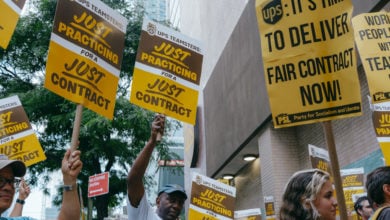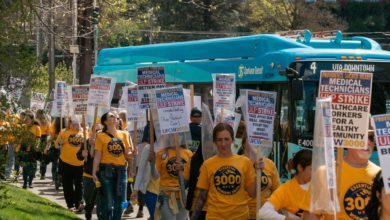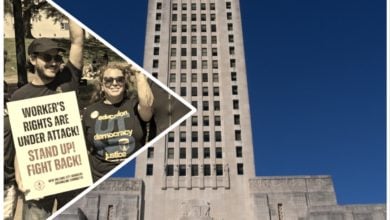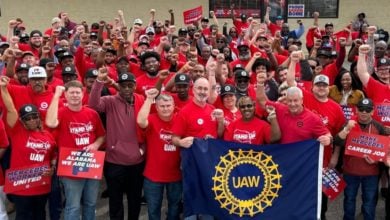A unit of 78 paraprofessionals in rural Cold Spring, Minnesota, ratified their contract after a months-long battle with school administrators. The unit has engaged in an impressive organizing campaign to win one of the largest package increases for paraprofessionals in the area. These wins include a 30% increase in employer contributions to healthcare, an 8-9% wage increase over two years, settlement payout on a multi-member grievance, and significant increases in longevity wage differentials. At a time when labor victories are resounding across the Twin Cities, this unit in Cold Spring, Minnesota proves that rural workers are not to be underestimated in their capacity to organize and win.
Paraprofessionals cited a variety of reasons for entering into the fight, with some of the largest issues being low pay and better staffing conditions. In 2023, the average paraprofessional in the school district made less than $22,000 a year. Many of the paraprofessionals worked multiple jobs in order to make ends meet at home. Workers also reported an alarming increase in neck injuries from caring for younger children, as well as understaffing during and after the height of the COVID-19 pandemic. Beyond workplace issues, paraprofessionals also reported feeling that there was a lack of appreciation for their work and that they were often treated as expendable and unimportant. One para reported that her building manager claimed “… it doesn’t matter if you [the paraprofessionals] go on strike, we have it covered.” School board members themselves made comments on publicly broadcasted meetings saying that paraprofessional work was a “part-time job” and “not enough to raise a family on, which is a choice.” These school board members even doubled down, saying that compared to paras, they “work in the real world” and “work all year.”
Let’s be clear; paraprofessionals do not get into this line of work to make a lot of money. Paraprofessionals overwhelmingly report that their primary motivation for entering the field was wanting to care for children who were left behind by conventional classroom structures. However, a sizable number of paras were forced to work one or two extra jobs to make ends meet.
Para work is socially reproductive; it not only helps children today but also models healthy and respectful relationships with children that they can carry forward into future interactions. One para said she hopes the kids she works with today will look back and say “Yes, she helped me. And now I know what to do with my [children].” They engage in their work because they understand that children are the key to our future. Every day, paraprofessionals engage in some of the most important work for society – teaching children how to develop into caring and compassionate adults.
When doing work like this, one job should be enough for these paraprofessionals to be able to raise their families. They should not have to work more shifts when the school day is over. This work is real work, even if school board members don’t see it as such.
For the paraprofessionals in Cold Spring, getting involved meant having a say in pushing the school board to do more than it had ever done before. One para reported that she became involved in the fight because “I believe we deserve a lot more than we get. I learned what the administration gets and it’s a lot more than we do.” The paras had consistently received contracts that marginally improved their conditions for years, but they wanted the school district to take their demands seriously.
The majority of paraprofessionals are women, and members of the school district characterized paraprofessionals as largely stay-at-home moms who didn’t need wage increases. This kind of characterization is prevalent in work considered “women’s work,” which largely consists of some form of caretaking or domestic labor. It begs the question of why people feel so comfortable saying that such work should be paid less or is less difficult than other work. A large part of the negotiations went beyond economics – this was about getting the school board to take the paras seriously and recognize the value of their work.
In order to be taken seriously, the paras had to be militant in their organization. They went to their peers and struck up conversations about contract negotiations and began to pull their coworkers into attending open negotiations, organizing actions, and planning meetings. Over the course of negotiations, union membership rose from under 80% to 100% by the time of ratification. Participation in planning was so high that the workers outside of the bargaining and contract action teams formed additional committees for logistics, escalation planning, and community outreach.
While school board members attempted to make the “union” out to be a third party that was pushing paras to escalate, the paras organized their own actions and marched on the administrative office to protest better contract terms. After all, what is a union if not an organization of and for your coworkers? The paras refused to fall for the school board’s attempt to alienate them from their union representation. When the school board continued to drag their feet on coming back with new terms, the paras took the next step – they filed to strike. This decision was not made lightly; the paras understood that going on strike meant they would face uncertainty and difficulty. However, they were willing to undergo that temporary strife if it meant that they could have long-term wins in their contract.
Despite intimidation and demeaning comments, the paras refused to break unity in their decision. When the paras filed to strike, the school board understood that they were serious. A paraprofessional who had worked at the district for over 20 years said, “… the administration realizes that we are willing to stick together [now] and that is a big plus. For once, someone has finally stood up to the school board.” Within two days, the school board acquiesced to the paras’ demands and agreed to one of the best contracts the paraprofessionals had ever seen.
By winning these contract terms, paras were able to keep health insurance affordable after the largest premium hike they had faced, raise starting wages to comparable levels throughout the region, and receive recognition for their dedication to their community. The increase in health insurance contributions was one of the largest increases in the unit’s history. The wage increase was twice as large as typical wage increases for the unit, and the paras had been fighting for years for an increase in longevity wage differentials. The terms of this contract contained the realization of years’ worth of hopes and dreams for the unit and provided them with not only financial gains but an increase in the dignity and recognition they have at work.
A victory like this in a rural part of Minnesota upends common misconceptions about the political consciousness of rural workers. Rural workers are often considered to be less pro-union than workers in urban centers. While national attention is often focused on labor battles in major cities and the coasts, workers in rural areas are building up their own militant movements to be seen, heard, and compensated. In their small school district, the paras recognized many of their community members when they went flyering, which made raising support for their contract fight markedly easier. When holding planning meetings, they patroned a local bar. The paraprofessionals used unique elements of small town life to their advantage to build up local support for their cause.
One para reflecting on organizing in a rural area said, “In the smaller school districts I think it’s easier. You have a smaller group of people and we can all get together and plan stuff… It’s easier for us to communicate with each other at work. It shows you it can be done”. Cold Spring is not a liberal region; residents vote overwhelmingly Republican. And yet when the paras began speaking out about their fight, community support was immense. Parents attended school board meetings to testify about what paraprofessionals had done for their children, incensed at the conditions the paras faced.
This victory also drives home important truths about what organizing is really all about. When this contract battle began a year ago, over a fifth of the paraprofessional unit was unorganized, with even the majority of existing members not actively participating in the union. Stewards and other union members raised union membership to 100% not by herding non-members around and telling them what to do, but by building a sense of empowerment through achievable asks and the protection of collective action.
Organizing is not about the union telling people that they need to do something to win. After all, who is “the union?” The union is the workers and their coworkers. By carrying out various actions, the workers realized that the capacity to win already existed within them. They built up unity and discipline within their ranks so that when the district dared them to go on strike, they could call the district’s bluff. This contract battle was a realization of power for the paraprofessionals – that their work was valuable, and that the school district would not run without them.
Above all, the paras said they entered into this fight for the kids. While they were out flyering the community, they ran into one of their students – he was out enjoying the day with his family. His face lit up, and so did theirs. The moment they saw that child, they had nothing but tenderness and care to give him. They were genuinely interested in his day, and excited to see him during the school week. There is a compassion that runs through their work that touches some core nerve that we all have deep down – the dream that the future will be better.
The paras wanted large wins so they could meet their own needs and thus be able to better meet the needs of others. The paras won because they understood that they would never win big unless they were disciplined, united, and dedicated. As one paraprofessional said, “I think these women deserve to have some level of safety so that they’re not always in survival mode working a job that takes care of so many people.” There is strength in caring for and serving our most vulnerable, and it is exactly this strength that they were able to transform into power and finally victory.






